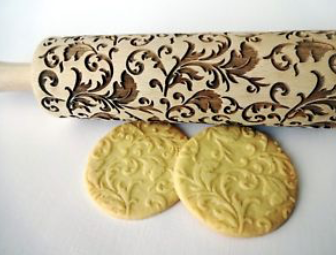Rolling pins
- rosemarydearman1
- Jan 9, 2019
- 4 min read

These are my two rolling pins, both of which have massive sentimental value to me. The long one at the back was bought in the early days of our marriage in Habitat in London. Habitat was one of those icon stores - the brainchild of Sir Terence Conran. I have no idea whether it still exists. But it had beautiful things and I thought this rolling pin was beautiful. It is very simple and rather pale and has served me well over the years.
The other one was made by one of my sons - I think my older son, who was not that handy at carpentry, though I'm not absolutely sure it was he. Whoever it was they did a good job on it. And whichever one it was, it was a gift from a son and I love that too.
I mostly use the larger one, but if I am rolling out chapatis or smaller things like that I use the smaller one.

People collect rolling pins. My cook/gardener friend has a collection in her kitchen. Her collection looks a bit like this one. It's amazing really how such a simple piece of kitchen equipment can be so varied. They come in all lengths, thicknesses, and colours. Different woods, and different ends. Some of these are probably very old - well mine is around fifty years old too. Though to me it looks just the same as when I bought it.
I tried to find out some historical facts, and did find a few but not many. Initially we just used our hands, and many people still do for things like scones, pizza, and flatbreads. It's an art. Then people just used stones to press 'pastry' flat. But these tended not to be smooth and the pastry stuck - well that's what the article said, but I don't really see why stones would have been any more sticky than a wooden one. They would have been heavy though, which, whilst it might have had advantages, was not really a good thing. And they would not have been the right shape for rolling.

In the eighteenth century there was apparently quite a fashion for glass rolling pins, such as this one. The stopper was so that you could put chilled water in it to keep the pastry cool. You're supposed to keep everything cold when you are rolling pastry. These days you can achieve the same thing by putting a metal one in the freezer before you use it. Not that I take much notice of the keeping everything cool mantra.
Nowadays, of course you can get all kinds of different fancy rolling pins made of just about any kind of material you can think of. And all different shapes and sizes. No doubt if you watch those bake-off programs they go on about them. The first type are embossed or carved so that when you roll the pastry there are patterns. And these may not be so new. Anyway here are a couple of examples.
In these days of fancy decorations on cakes I'm sure there is a booming trade in such things.

Then there is this one. Apparently you can adjust those round things at the end and it will adjust the height of the rolling pin so that you get just the right thickness of pastry. Which sounds a bit precious to me.
But a rolling pin is not just for rolling out pastry. You can use it for other things too. And this is where cooking as therapy comes in.
You can crush crunchy things with it. When I was a child my sister and I used to crush salt for my grandmother. She used to buy it in a block. Then she would cut thick slices which we would then roll out - backwards and forwards until it was all reduced to fine grains which were then funnelled into a jar or a salt shaker. I think we used to put it between two sheets of greaseproof paper but maybe not. It was very satisfying though.

You can also use the same technique for other crunchy things, like pralines and nuts I guess, crunchy bars too. It was also soothing. Maybe there was something therapeutic about squashing stuff - like mud pies.
Then you can bash things with it which is hugely therapeutic. If you are angry or cross you can vent all that frustration on the piece of meat (it's usually meat) you have put between two sheets of paper to flatten. Chicken breasts for example.

Which brings me to why I am writing about rolling pins. Whilst reading through Nigella Express I came across a recipe for fast fries. Very simple and good when you are feeling cross - I wonder whether Nigella was when she invented this. You simply take some new potatoes - we don't have them here, but what she means is small potatoes - so chat potatoes I guess. English new potatoes taste absolutely divine of course, but nothing I can do about that. We just don't have them here. Anyway put them in a freezer bag and 'hit them with a rolling pin until they are broken into pieces'. I think this would take some force, so she was maybe feeling very angry. Then heat some oil in a frying pan and when it is hot, add the potatoes and cook for 5-6 minutes a side with the pan partially covered. Drain and you're done! Sounds good, looks good. Very easy. Must try it some time.
So a new use for a rolling pin.
















Comments